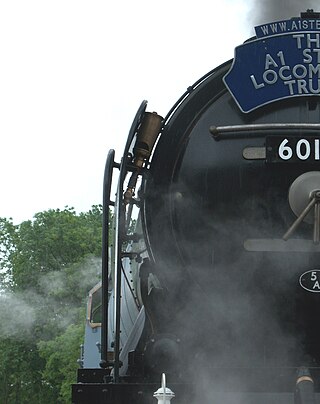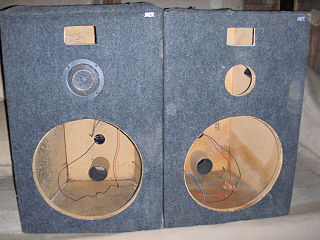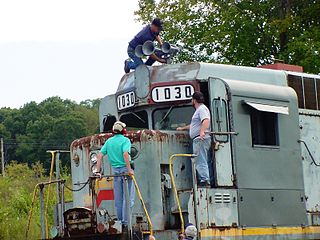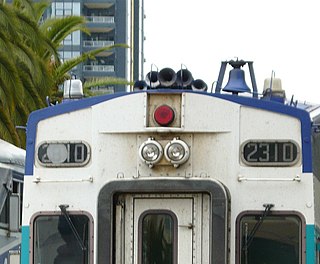
A steam whistle is a device used to produce sound in the form of a whistle using live steam, which creates, projects, and amplifies its sound by acting as a vibrating system. [1]

A steam whistle is a device used to produce sound in the form of a whistle using live steam, which creates, projects, and amplifies its sound by acting as a vibrating system. [1]
The whistle consists of the following main parts, as seen on the drawing: the whistle bell (1), the steam orifice or aperture (2), and the valve (9).
When the lever (10) is actuated (usually via a pull cord), the valve opens and lets the steam escape through the orifice. The steam will alternately compress and rarefy in the bell, creating the sound. The pitch, or tone, is dependent on the length of the bell; and also how far the operator has opened the valve. Some locomotive engineers invented their own distinctive style of whistling.
Steam whistles were often used in factories and similar places to signal the start or end of a shift, etc. Steam railway locomotives, traction engines, and steam ships have traditionally been fitted with a steam whistle for warning and communication purposes. Large diameter, low-pitched steam whistles were used on light houses, likely beginning in the 1850s. [2]
The earliest use of steam whistles was as boiler low-water alarms [3] in the 18th century [4] and early 19th century. [5] During the 1830s, whistles were adopted by railroads [6] and steamship companies. [7]
Steam warning devices have been used on trains since 1833, [8] when George Stephenson invented and patented a steam trumpet for use on the Leicester and Swannington Railway. [9] Period literature makes a distinction between a steam trumpet and a steam whistle. [10] A copy of the trumpet drawing signed May 1833 shows a device about eighteen inches high with an ever-widening trumpet shape with a six-inch diameter at its top or mouth. [8] It is said that George Stephenson invented his trumpet after an accident on the Leicester and Swannington Railway where a train hit either a cart, or a herd of cows, on a level crossing and there were calls for a better way of giving a warning. Although no-one was injured, the accident was deemed serious enough to warrant Stephenson's personal intervention. One account states that [driver] Weatherburn had 'mouthblown his horn' at the crossing in an attempt to prevent the accident, but that no attention had been paid to this audible warning, perhaps because it had not been heard.
Stephenson subsequently called a meeting of directors and accepted the suggestion of the company manager, Ashlin Bagster, that a horn or whistle which could be activated by steam should be constructed and fixed to the locomotives. Stephenson later visited a musical instrument maker on Duke Street in Leicester, who on Stephenson's instructions constructed a 'Steam Trumpet' which was tried out in the presence of the board of Directors ten days later.
Stephenson mounted the trumpet on the top of the boiler's steam dome, which delivers dry steam to the cylinders. The company went on to mount the device on its other locomotives
Locomotive steam trumpets were soon replaced by steam whistles. Air whistles were used on some diesel and electric locomotives, but these mostly employ air horns.
An array of steam whistles arranged to play music is referred to as a calliope.
In York, Pennsylvania, a variable pitch steam whistle at the New York Wire Company has been played annually on Christmas Eve since 1925 (except in 1986 and 2005) in what has come to be known as "York's Annual Steam Whistle Christmas Concert". On windy nights, area residents report hearing the concert as far as 12 to 15 miles away. The whistle, which is in the Guinness Book of World Records, was powered by an air compressor during the 2010 concert due to the costs of maintaining and running the boiler. [11] [12] [13] [14] [15] [16]
Beginning in 1869, [17] steam whistles began being installed at lighthouse stations as a way of warning mariners in periods of fog, when the lighthouse is not visible. 10" diameter whistles were used as fog signals throughout the United States for many years, [17] until they were later replaced by other compressed air diaphragm or diaphone horns.
A whistle has a characteristic natural resonant frequency [30] that can be detected by gently blowing human breath across the whistle rim, much as one might blow over the mouth of a bottle. The active sounding frequency (when the whistle is blown on steam) may differ from the natural frequency as discussed below. These comments apply to whistles with a mouth area at least equal to the cross-sectional area of the whistle.
Whistle sound level varies with several factors:
Acoustic length [75] or effective length [76] is the quarter wavelength generated by the whistle. It is calculated as one quarter the ratio of speed of sound to the whistle's frequency. Acoustic length may differ from the whistle's physical length, [77] also termed geometric length. [78] depending upon mouth configuration, etc. [30] The end correction is the difference between the acoustic length and the physical length above the mouth. The end correction is a function of diameter whereas the ratio of acoustic length to physical length is a function of scale. These calculations are useful in whistle design to obtain a desired sounding frequency. Working length in early usage meant whistle acoustic length, i.e., the effective length of the working whistle, [79] but recently has been used for physical length including the mouth. [80]
Loudness is a subjective perception that is influenced by sound pressure level, sound duration, and sound frequency. [73] [74] High sound pressure level potential has been claimed for the whistles of Vladimir Gavreau, [81] who tested whistles as large as 1.5 meter (59-inch) diameter (37 Hz). [82]
A 20-inch diameter ring-shaped whistle (“Ultrawhistle”) patented and produced by Richard Weisenberger sounded 124 decibels at 100 feet. [83] The variable pitch steam whistle at the New York Wire Company in York, Pennsylvania, was entered in the Guinness Book of World Records in 2002 as the loudest steam whistle on record at 124.1dBA from a set distance[ clarify ] used by Guinness. [84] The York whistle was also measured at 134.1 decibels from a distance of 23-feet. [12]
A fire-warning whistle supplied to a Canadian saw mill by the Eaton, Cole, and Burnham Company in 1882 measured 20 inches in diameter, four feet nine inches from bowl to ornament, and weighed 400 pounds. The spindle supporting the whistle bell measured 3.5 inches diameter and the whistle was supplied by a four-inch feed pipe. [85] [86]
Other records of large whistles include an 1893 account of U.S. President Grover Cleveland activating the “largest steam whistle in the world,” said to be “five feet” at the Chicago World's Fair. [87] [88]
The sounding chamber of a whistle installed at the 1924 Long-Bell Lumber Company, Longview, Washington measured 16 inches diameter x 49 inches in length. [89]
The whistle bells of multi-bell chimes used on ocean liners such as the RMS Titanic measured 9, 12, and 15 inches diameter. [90]
The whistle bells of the Canadian Pacific steamships Assiniboia and Keewatin measured 12 inches in diameter and that of the Keewatin measured 60 inches in length. [91] [92]
A multi-bell chime whistle installed at the Standard Sanitary Manufacturing Company in 1926 was composed of five separate whistle bells measuring 5 x15, 7 x 21, 8x 24, 10 x 30, and 12 x36 inches, all plumbed to a five-inch steam pipe. [93]
The Union Water Meter Company of Worcester Massachusetts produced a gong whistle[ clarify ] composed of three bells, 8 x 9-3/4, 12 x 15, and 12 x 25 inches. [94] Twelve-inch diameter steam whistles were commonly used at light houses in the 19th century. [95]
It has been claimed that the sound level of an Ultrawhistle would be significantly greater than that of a conventional whistle, [96] but comparative tests of large whistles have not been undertaken. Tests of small Ultrawhistles have not shown higher sound levels compared to conventional whistles of the same diameter. [70]
A calliope is an American and Canadian musical instrument that produces sound by sending a gas, originally steam or, more recently, compressed air, through large whistles—originally locomotive whistles.

A loudspeaker is an electroacoustic transducer that converts an electrical audio signal into a corresponding sound. A speaker system, also often simply referred to as a speaker or loudspeaker, comprises one or more such speaker drivers, an enclosure, and electrical connections possibly including a crossover network. The speaker driver can be viewed as a linear motor attached to a diaphragm which couples that motor's movement to motion of air, that is, sound. An audio signal, typically from a microphone, recording, or radio broadcast, is amplified electronically to a power level capable of driving that motor in order to reproduce the sound corresponding to the original unamplified electronic signal. This is thus the opposite function to the microphone; indeed the dynamic speaker driver, by far the most common type, is a linear motor in the same basic configuration as the dynamic microphone which uses such a motor in reverse, as a generator.

Wind chimes are a type of percussion instrument constructed from suspended tubes, rods, bells or other objects that are often made of metal or wood. The tubes or rods are suspended along with some type of weight or surface which the tubes or rods can strike when they or another wind-catching surface are blown by the natural movement of air outside. They are usually hung outside of a building or residence as a visual and aural garden ornament. Since the percussion instruments are struck according to the random effects of the wind blowing the chimes, wind chimes have been considered an example of chance-based music. The tubes or rods may sound either indistinct pitches, or fairly distinct pitches. Wind chimes that sound fairly distinct pitches can, through the chance movement of air, create simple songs or broken chords.

A horn loudspeaker is a loudspeaker or loudspeaker element which uses an acoustic horn to increase the overall efficiency of the driving element(s). A common form (right) consists of a compression driver which produces sound waves with a small metal diaphragm vibrated by an electromagnet, attached to a horn, a flaring duct to conduct the sound waves to the open air. Another type is a woofer driver mounted in a loudspeaker enclosure which is divided by internal partitions to form a zigzag flaring duct which functions as a horn; this type is called a folded horn speaker. The horn serves to improve the coupling efficiency between the speaker driver and the air. The horn can be thought of as an "acoustic transformer" that provides impedance matching between the relatively dense diaphragm material and the less-dense air. The result is greater acoustic output power from a given driver.

A siren is a loud noise-making device. Civil defense sirens are mounted in fixed locations and used to warn of natural disasters or attacks. Sirens are used on emergency service vehicles such as ambulances, police cars, and fire engines. There are two general types: mechanical and electronic.

Scaling is the ratio of an organ pipe's diameter to its length. The scaling of a pipe is a major influence on its timbre. Reed pipes are scaled according to different formulas than for flue pipes. In general, the larger the diameter of a given pipe at a given pitch, the fuller and more fundamental the sound becomes.

A horn antenna or microwave horn is an antenna that consists of a flaring metal waveguide shaped like a horn to direct radio waves in a beam. Horns are widely used as antennas at UHF and microwave frequencies, above 300 MHz. They are used as feed antennas for larger antenna structures such as parabolic antennas, as standard calibration antennas to measure the gain of other antennas, and as directive antennas for such devices as radar guns, automatic door openers, and microwave radiometers. Their advantages are moderate directivity, broad bandwidth, low losses, and simple construction and adjustment.

A train whistle or air whistle is an audible signaling device on a steam or gas locomotive, used to warn that the train is approaching, and to communicate with rail workers. Modern diesel and electric locomotives primarily use a powerful air horn instead of a whistle as an audible warning device. However, the word whistle continues to be used by railroaders in referring to such signaling practices as "whistling off".

An organ pipe is a sound-producing element of the pipe organ that resonates at a specific pitch when pressurized air is driven through it. Each pipe is tuned to a note of the musical scale. A set of organ pipes of similar timbre comprising the complete scale is known as a rank; one or more ranks constitutes a stop.

An air horn is a pneumatic device designed to create an extremely loud noise for signaling purposes. It usually consists of a source which produces compressed air, which passes into a horn through a reed or diaphragm. The stream of air causes the reed or diaphragm to vibrate, creating sound waves, then the horn amplifies the sound making it louder. Air horns are widely employed as vehicle horns, installed on large buses, semi-trailer trucks, fire trucks, trains, and some ambulances as a warning device, and on ships as a signaling device.

Helmholtz resonance or wind throb is the phenomenon of air resonance in a cavity, such as when one blows across the top of an empty bottle. The name comes from a device created in the 1850s by Hermann von Helmholtz, the Helmholtz resonator, which he used to identify the various frequencies or musical pitches present in music and other complex sounds.

A speaking tube or voicepipe is a device based on two cones connected by an air pipe through which speech can be transmitted over an extended distance.
An acoustic horn or waveguide is a tapered sound guide designed to provide an acoustic impedance match between a sound source and free air. This has the effect of maximizing the efficiency with which sound waves from the particular source are transferred to the air. Conversely, a horn can be used at the receiving end to optimize the transfer of sound from the air to a receiver.

A loudspeaker enclosure or loudspeaker cabinet is an enclosure in which speaker drivers and associated electronic hardware, such as crossover circuits and, in some cases, power amplifiers, are mounted. Enclosures may range in design from simple, homemade DIY rectangular particleboard boxes to very complex, expensive computer-designed hi-fi cabinets that incorporate composite materials, internal baffles, horns, bass reflex ports and acoustic insulation. Loudspeaker enclosures range in size from small "bookshelf" speaker cabinets with 4-inch (10 cm) woofers and small tweeters designed for listening to music with a hi-fi system in a private home to huge, heavy subwoofer enclosures with multiple 18-inch (46 cm) or even 21-inch (53 cm) speakers in huge enclosures which are designed for use in stadium concert sound reinforcement systems for rock music concerts.

A train horn is an air horn used as an audible warning device on diesel and electric-powered trains. Its primary purpose is to alert persons and animals to an oncoming train, especially when approaching a level crossing. They are often extremely loud, allowing them to be heard from great distances. They are also used for acknowledging signals given by railroad employees, such as during switching operations. For steam locomotives, the equivalent device is a train whistle.

Nathan Manufacturing, Inc. is a division of Micro Precision Group which manufactures Airchime, Ltd. train horns mainly for North America. It is one of two major train horn manufacturers in the United States, with Leslie Controls, Inc. being the other.

A wind instrument is a musical instrument that contains some type of resonator in which a column of air is set into vibration by the player blowing into a mouthpiece set at or near the end of the resonator. The pitch of the vibration is determined by the length of the tube and by manual modifications of the effective length of the vibrating column of air. In the case of some wind instruments, sound is produced by blowing through a reed; others require buzzing into a metal mouthpiece, while yet others require the player to blow into a hole at an edge, which splits the air column and creates the sound.

A vehicle horn is a sound-making device installed on motor vehicles, trains, boats, and other types of vehicles. The horn is activated to warn others of the vehicle's presence or approach, or to call attention to some hazard. Motor vehicles, ships and trains are required by law in some countries to have horns. Trams, trollies, streetcars, and even bicycles are also legally required to have an audible warning device in many areas.
The whirly tube, corrugaphone, or bloogle resonator, also sold as Free-Ka in the 1960s-1970s, is an experimental musical instrument which consists of a corrugated (ribbed) plastic tube or hose, open at both ends and possibly wider at one end (bell), the thinner of which is rotated in a circle to play. It may be a few feet long and about a few inches wide. The faster the toy is swung, the higher the pitch of the note it produces, and it produces discrete notes roughly belonging to the harmonic series, like a valveless brass instrument generates different modes of vibration. However, the first and the second modes, corresponding to the fundamental and the second harmonics, are reported as being difficult to excite. To be played in concert the length of the tube must be trimmed to tune it.

A vessel flute is a type of flute with a body which acts as a Helmholtz resonator. The body is a vessel-shaped, not a tube- or cone-shaped; that is, the far end is closed.